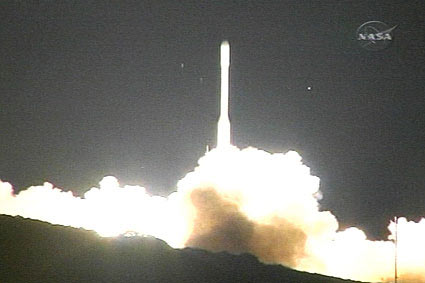NASA Pinpoints Causes for Climate Satellite Crash

NASA hasfound four potential causes for the loss of a $273 million climate satellite thatcrashed into the ocean just after its launch earlier this year, the spaceagency said Friday in a new report.
The advancedOrbiting Carbon Observatory satellite, built to study atmospheric Earth?s carbondioxide levels, launched spaceward on Feb. 24 aboard a Taurus XL rocket from California?s Vandenberg Air Force Base, but it failed to reach orbit. Instead, it fellback to Earth and crashed into the ocean waters near Antarctica.
Thespacecraft was NASA's first satellite built exclusively tomap carbon dioxide levels on Earth and understand how humanity'scontribution of the greenhouse gas is affecting global climate change.
Japan's recently launched "Ibuki"climate-studying spacecraft, as well as other satellites already in orbit,may be able to compensate for the lack of OCO.
The MishapInvestigation Board led by Rick Obenschain, deputy director at NASA's GoddardSpace Flight Center in Greenbelt, Md., verified that the Taurus launch vehiclefairing failed to separate upon command. The fairing is a clamshell structurethat encapsulates the satellite as it travels through the atmosphere. Thefailure to shed the fairing mass prevented the satellite from reaching itsplanned orbit and resulted in its destruction.
The boardidentified four potential causes that could have resulted in the fairing notseparating:
- A failure of the frangible joint subsystem. A frangible joint is an explosive device that provides instantaneous separation of flight vehicle structures while maintaining confinement of explosive debris.
- A failure in the electrical subsystem that prevented sufficient electrical current to initiate the required ordnance devices.
- A failure in the pneumatic system, which supplies pressure to thrusters which separate the fairing.
- A cord snagged on a frangible joint side rail nut plate.
The panelalso provided recommendations to prevent any future problems associated withthe four hardware components that could have caused the OCO accident.
Breaking space news, the latest updates on rocket launches, skywatching events and more!
Since its1994 debut, the Taurus rocket has flown six successful missions out of eightlaunches to orbit 12 satellites. The last Taurus launch reached spacesuccessfully in 2004. The one failure before Tuesday's contingency occurredin September 2001.
Thesix-member board began its investigation in early March. The panel conductedhardware testing; performed and reviewed engineering analysis and simulationdata; reviewed telemetry data; collected and secured more than 2,000 documents;and conducted 78 interviews of critical personnel associated with the mission.
- Video - What the OCO Mission Would Have Done
- NASA Climate Satellite Crashes in Ocean After Launch Failure
- Japan Launches Satellite to Track Greenhouse Gases

Space.com is the premier source of space exploration, innovation and astronomy news, chronicling (and celebrating) humanity's ongoing expansion across the final frontier. Originally founded in 1999, Space.com is, and always has been, the passion of writers and editors who are space fans and also trained journalists. Our current news team consists of Editor-in-Chief Tariq Malik; Editor Hanneke Weitering, Senior Space Writer Mike Wall; Senior Writer Meghan Bartels; Senior Writer Chelsea Gohd, Senior Writer Tereza Pultarova and Staff Writer Alexander Cox, focusing on e-commerce. Senior Producer Steve Spaleta oversees our space videos, with Diana Whitcroft as our Social Media Editor.
